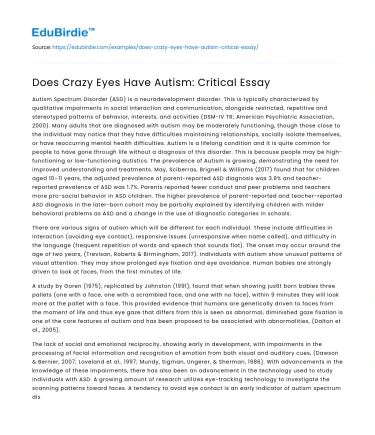Autism Spectrum Disorder (ASD) is a neurodevelopment disorder. This is typically characterized by qualitative impairments in social interaction and communication, alongside restricted, repetitive and stereotyped patterns of behavior, interests, and activities (DSM-IV TR; American Psychiatric Association, 2000). Many adults that are diagnosed with autism may be moderately functioning, though those close to the individual may notice that they have difficulties maintaining relationships, socially isolate themselves, or have reoccurring mental health difficulties. Autism is a lifelong condition and it is quite common for people to have gone through life without a diagnosis of this disorder. This is because people may be high-functioning or low-functioning autistics. The prevalence of Autism is growing, demonstrating the need for improved understanding and treatments. May, Sciberras, Brignell & Williams (2017) found that for children aged 10–11 years, the adjusted prevalence of parent-reported ASD diagnosis was 3.9% and teacher-reported prevalence of ASD was 1.7%. Parents reported fewer conduct and peer problems and teachers more pro-social behavior in ASD children. The higher prevalence of parent-reported and teacher-reported ASD diagnosis in the later-born cohort may be partially explained by identifying children with milder behavioral problems as ASD and a change in the use of diagnostic categories in schools.
There are various signs of autism which will be different for each individual. These include difficulties in interaction (avoiding eye contact), responsive issues (unresponsive when name called), and difficulty in the language (frequent repetition of words and speech that sounds flat). The onset may occur around the age of two years, (Trevisan, Roberts & Birmingham, 2017). Individuals with autism show unusual patterns of visual attention. They may show prolonged eye fixation and eye avoidance. Human babies are strongly driven to look at faces, from the first minutes of life.
Save your time!
We can take care of your essay
- Proper editing and formatting
- Free revision, title page, and bibliography
- Flexible prices and money-back guarantee
A study by Goren (1975), replicated by Johnston (1991), found that when showing jus6t born babies three pallets (one with a face, one with a scrambled face, and one with no face), within 9 minutes they will look more at the pallet with a face. This provided evidence that humans are genetically driven to faces from the moment of life and thus eye gaze that differs from this is seen as abnormal, diminished gaze fixation is one of the core features of autism and has been proposed to be associated with abnormalities, (Dalton et al., 2005).
The lack of social and emotional reciprocity, showing early in development, with impairments in the processing of facial information and recognition of emotion from both visual and auditory cues, (Dawson & Bernier, 2007; Loveland et al., 1997; Mundy, Sigman, Ungerer, & Sherman, 1986). With advancements in the knowledge of these impairments, there has also been an advancement in the technology used to study individuals with ASD. A growing amount of research utilizes eye-tracking technology to investigate the scanning patterns toward faces. A tendency to avoid eye contact is an early indicator of autism spectrum disorder (ASD), and difficulties with eye contact often persist throughout the lifespan. Eye contact difficulties may underlie social cognitive deficits in ASD, and can create significant social and occupational barriers. Klein (2002) was the first study that used eye-tracking to objectively quantify which visual attention patterns were displayed in individuals with ASD. While viewing movie extracts, eye-tracking technology measured visual fixations in the atypical and typical groups. This study found that adults with ASD had atypical viewing patterns compared to the typically developed group. When the group data was analyzed it showed that the atypical group spent the most time viewing the mouth and then objects whereas the typical group spent more time viewing the eyes and then the mouth. Thus Individuals with ASD spend more time viewing the mouth and often look less into the eyes (Pelphrey et al., 2002; Klin et al., 2002). There are several explains to why autistics have abnormal viewing patterns toward faces. First, it may be they look less into the eyes because they have a sensitivity to the eyes which results in emotional distress (Kylliainen and Hietanen, 2006; Dalton et al., 2005). Secondly, it may be that they are abnormally attracted to the mouth because it offers key features such as movement and voice projection. Lastly, it may be that they find looking at the mouth a compensatory strategy to extract social meaning from other parts of the face when the eyes are less informative to people with autism.
Following Klein’s study, the only other study to involve movie extracts in the study of eye gaze was Speer, Cook, McMahonl, and Clark (2007). Researchers used static and movie extracts and concluded that there was only atypically eye gaze with the moving movie extracts and not for static stimuli. This shows that these differences in viewing patterns may be stimuli-specific and not just associated with autism.






 Stuck on your essay?
Stuck on your essay?

